Generating leads for your eCommerce business is tricky if you don’t have the right strategies in place. Even the most well-known brands are always looking for ways to drum up new business.
In other words: generation strategies are a long-term love affair.
They carry you through peak and low seasons — times of plenty and times of want.
They’re there to automate your processes and bring you prospects in your sleep.
Whether you’re a marketing newbie or an experienced marketer, the following 10 lead generation strategies will help you get started.
Lead Generation Strategies for eCommerce:
2. Automate Your Lead Generation Process
3. Add Lead Magnets to Your Landing Pages, Articles, and Website
5. Embed Contact Forms on Your Landing Pages, Articles, and Website
6. Collect Lead Data Through Chat Bots
8. Make It Easy For Customers to Give You Their Contact Details
9. Lead Customers to You With an SEO Strategy
10. Run Pay-Per-Click (PPC) Ads
1. Set Up an Email List
Email is one of the most commonly used tools for marketing and communication. In 2021, 4 billion people had an email account. That number is projected to reach 4.48 billion by 2024.
That’s why it’s no surprise that email addresses have become digital currency. With lists of quality email addresses, eCommerce businesses can create endless sales and marketing opportunities.

To set up an email list, try an email marketing tool like Wishpond. With Wishpond, you can automatically send welcome emails, reminders, and newsletters. You can also customize different follow-up sequences for leads depending on what data you collected about them.
Once your account is set up, you can email your prospects a few times per week with surveys, product updates, and personalized content.
Create an Email Outreach Plan
To build long-lasting relationships with your prospects, it’s important to send them consistent content. Creating an email outreach plan will help you get there.
Here are some email outreach plan ideas:
- Plan to send two emails a week — a promotional email and a personalized story
- Plan to send 10 emails per month — a mix of promotional emails, personalized stories, surveys, and product updates
- Plan to send one newsletter per month and one weekly promotional email with a personalized touch
Add opt-in buttons and offers
Don’t forget to add an opt-in button or offer to every email and encourage prospects to share content with their friends. This way, if their friends see your content, they can choose to opt-in to your newsletter or offer, giving you a new lead.
2. Automate Your Lead Generation Process
Automating your lead generation process means creating systems that bring leads to you in your sleep.

For this to work, you’ll need to add lead magnets and calls to action (CTAs) to all of the marketing examples below, so be sure to plan those well in advance.
As far as systems go, here’s what you’ll need to automate:
Social media posts
Plan your social media content (including hashtags) one to two months in advance. Then, use a post-scheduling tool like ContentCal to automate your posts.
Blog posts
Plan your blog posts three months out, then use your blog platform’s scheduling tool to automate them. For instance, if you own a WordPress blog, learn how to schedule blog posts.
Email blasts
Plan your email content a month in advance, and then use an email scheduling tool like MailChimp or Wishpond to automate your blasts.
Funnels
Plan your funnels three to six months in advance and use a funnel scheduling tool to automate sequences. Use a tool like Kartra to create and automate your funnels.
3. Add Lead Magnets and CTAs to Your Landing Pages, Articles, and Website
The term “lead magnet” in marketing means a free item or service you give away to get contact details. Marketers use lead magnets to generate leads. Every time they collect someone’s contact information, they gain a new lead.
If you’ve ever signed up for a free online webinar, gift, or course, you’ve clicked on a lead magnet before. It probably said something like, “click here to get your gift,” or, “download your course here.”
Here’s an example:
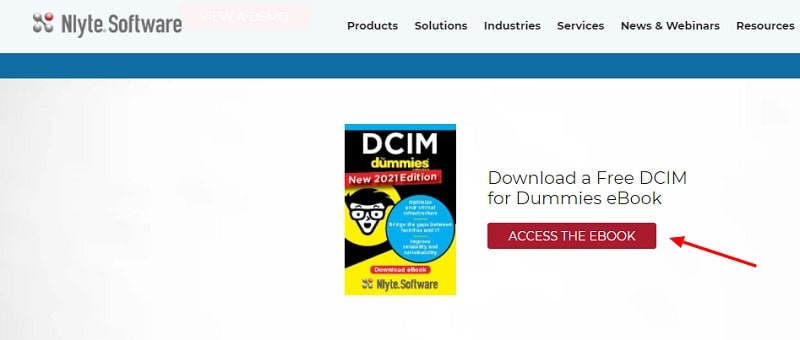
Adding lead magnets to all customer touchpoints and marketing content you publish is crucial to generating leads.
To entice customers, even more, consider using high-definition videos next to your lead magnets.
Here’s an example:
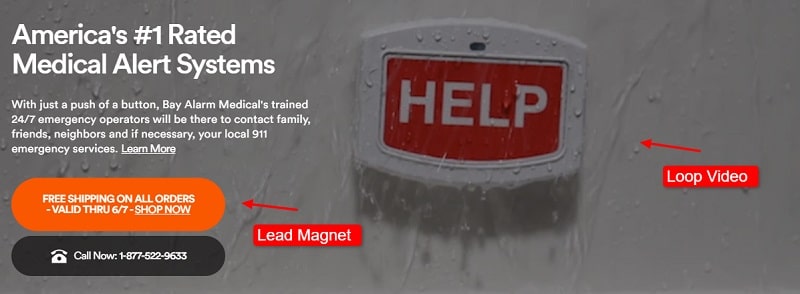
A CTA in marketing means inviting a user to take a specific action. Marketers use CTAs to persuade users to do something. For instance, at the end of a blog post, you might read “watch our tutorial,” or at the end of a social media post, you might read, “leave a comment below,” or, “what are you doing this weekend?”

CTAs are a great way to encourage potential prospects to engage with your content. Once they get to know you, they might be interested in signing up for an offer or buying a product.
4. Start an Affiliate Program
Affiliate marketing is when an affiliate earns commissions for marketing another company’s products. Affiliates promote the company’s product and earn a slice of the profits from each sale they make. You track these sales through an affiliate link, which helps your business know exactly how many products affiliates are selling and how much you have to payout.
Here’s an example from Credit Saint. It uses affiliates to promote its credit repair services. In this example, its affiliate Simple Money Lyfe is promoting services in blog posts:

Throughout the article, they have three CTA buttons inviting readers to try Credit Saint Review:
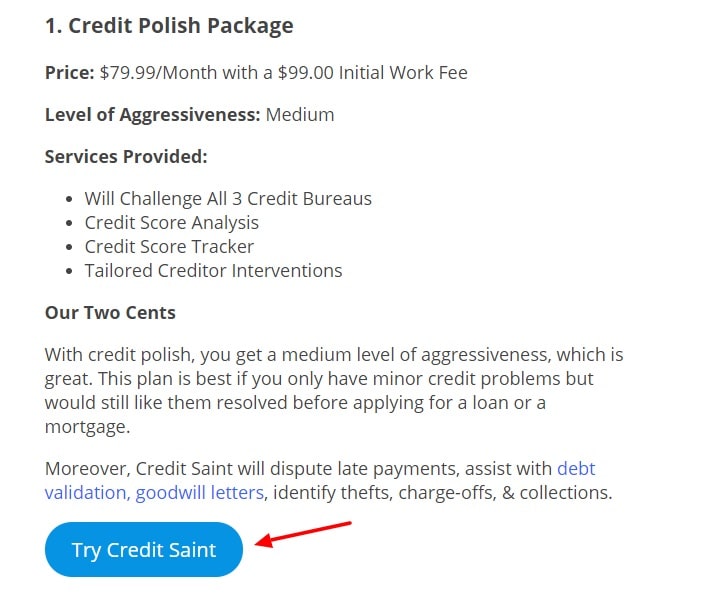
When a reader clicks on a CTA button, they’re led to a form where they can input their contact details. If they choose to submit their information, Credit Saint receives it and adds that reader to its lead list.
Before Starting an Affiliate Program
Before starting an affiliate program, you need to decide:
- Which affiliates to use
- How much commission you’re going to pay affiliates
- How to track sales and pay affiliates (check out Tipalti)
As far as which affiliates to choose, try reaching out to micro or nano influencers. They’re experienced in marketing to niche audiences and are much cheaper than traditional influencers.
Use an influencer search tool like Upfluence to find them.
5. Embed Contact Forms on Your Landing Pages, Articles, and Website
Embedding contact forms on your landing pages, articles, and website is an easy way to collect information without exerting too much time or effort.
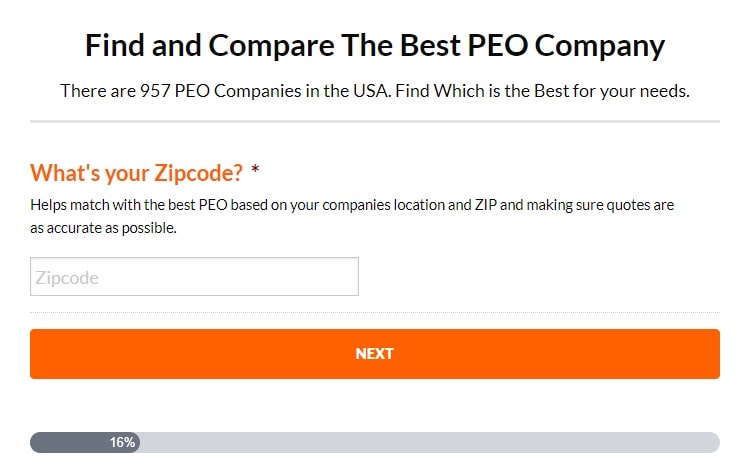
You can also set up your contact forms to collect user needs and preferences, so you know what kind of content to create and what product recommendations to offer.
For instance, one of your contact fields can read ‘which one of our products would you like to try the most?’
If they write “bath bomb,” you can send them bath bomb tutorials and a list of wellness benefits.
If they want to try a Tempurpedic pillow, you can send them a discount on their first purchase and a product demonstration video. Just make sure all of your marketing content has CTAs and lead magnets included throughout.
What fields should I include on my contact forms?
Be sure to include basic contact fields as well as user preference fields.
For instance:
- Name
- Phone number
- Zipcode
- Which of our products would you like to try? (Provide choices)
- How would you describe yourself? (Provide choices)
6. Collect Lead Data Through Chatbots
A chatbot is a software app that conducts online chat conversions. If a user asks the chatbot a question via text or text-to-speech, the chatbot automatically responds with an answer.
You’ll usually see a chatbot pop up at the bottom right-hand corner of a webpage if it’s installed.
Not only do chatbots answer basic questions, so users don’t have to contact a live agent, but they’re also great marketing tools.
You can use a chatbot to:
- Offer discounts
- Run surveys
- Ask users questions
- Recommend products
- Invite users to sign up for your email newsletter
You can also use them to follow up with users who were disconnected from your site like Track-POD does in this example:
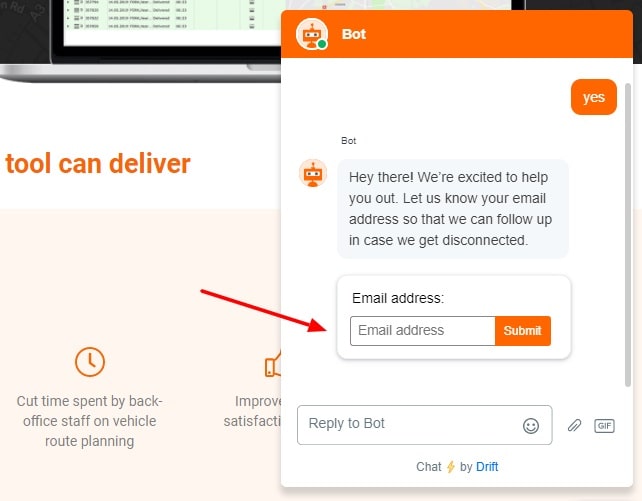
Whatever marketing tactics you choose, make sure that your chatbot asks for the user’s contact information — otherwise, you won’t generate a new lead.
7. Offer a Free Trial
Whether you sell digital or physical products, offering a free trial can be a great way to show prospects what you’re about in a low-stakes environment. In other words, since they’re not obligated to pay for anything yet, there’s nothing for them to lose.
If you decide to do this, plan out your CTA buttons ahead of time.
Here’s an example of a button:
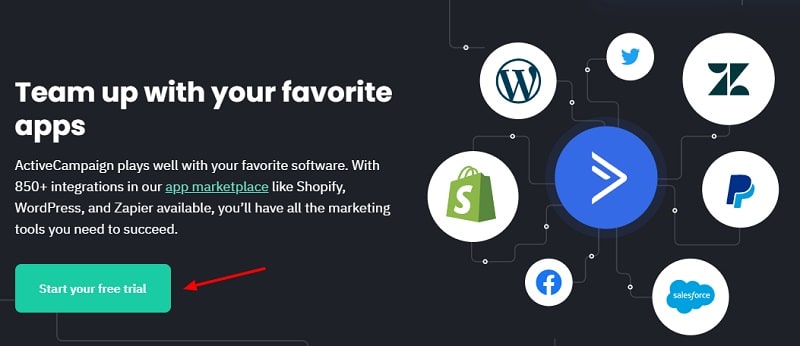
You can use these buttons:
- In your eCommerce store
- In your email blasts and ads
- On your blog, website, and landing pages
If you sell physical products
If you sell physical products, you can:
- Offer free product samples to prospects — let them choose up to a certain amount of products to try.
- Offer product demonstrations with samples — demonstrations can be in person with a consultant (great for MLM companies) or online.
- Create a VIP portal and give prospects temporary login credentials. The portal will have free samples they can order, plus product videos.
If you sell digital products
If you sell digital products, you’ll need to create a portal that prospects can access with temporary login credentials. Make sure to set up the trial so that prospects can test-drive all of your features. This will help them get a realistic idea of how these features work.
After the trial ends
After a prospect’s trial ends, don’t forget about them. Make sure they’re on your email list, keep an eye on their preferences, and recommend relevant offers when appropriate. The key here is to really know your customer. If you understand who your customer is and what they care about, you’ll be able to build a relationship with them over time. Bonus tip: consider using a customer data platform (CDP) to manage and collect detailed customer profiles.
8. Make It Easy For Customers to Give You Their Contact Details
The key to generating leads is making it easy for prospects to give you their contact details.
Have you ever seen a relevant offer you were excited about (i.e., a free ebook), but when you go to claim it, you’re taken through a series of slow windows? Do you continue through the process until you get your ebook, or do you bail because the web pages are loading slowly, and they’re asking for your entire life story and firstborn child?
Chances are, if it took too long and they asked for too much, you bailed.
That’s why it’s crucial to make it easy for prospects to sign up for relevant offers.
The easiest way to do that is:
- Make sure your pages load quickly and seamlessly
- Provide a relevant offer you know they’ll love
- Provide different sign-up options, so prospects don’t have to type in their details manually
For instance, in its article on Agile project management, monday.com has three CTA buttons.
If you click on one, it leads you to a sign-up page where prospects can sign up using Google, Slack, or Linkedin.
You can also have prospects sign-up through Facebook or another social media platform. Whatever you choose, make sure they’re easy, and prospects have existing accounts there.
9. Lead Customers to You With an SEO Strategy
When customers shop for products online, where do they start? In most cases, they search for the products they want on search engines like Google.
An SEO strategy helps you improve your landing pages, social media copy, website, and blog so that your pages rank in the search results. In other words, when your prospects look for something, they’ll find you.
For instance, take a look at this Google search results example:

In this example, we wrote “social media contests and promotions” in Google’s search bar. As a result, our article called “Social Media Contests: 50 Ideas, Tips and Examples” ranked in position number two. But that wouldn’t have been possible without a strong SEO strategy in place.
For more detailed tips on designing an SEO strategy, check out our in-depth article “The Beginner’s Guide to SEO for Small Business.”
10. Run Pay-Per-Click (PPC) Ads
PPC ads help you focus your marketing budget on people who actively search for your products.
Although SEO is better for long-term lead generation, running PPC ads through Google Adwords is an effective way to reach searchers.
PPC ads are also a great way to include competitive keywords that your competitors typically dominate.
With PPC ads, you decide where you want to display your ads based on user searches. Then, you set bids based on how much you’re willing to pay for each click to your landing pages, store, or website. You only pay when someone clicks on your ad.
Here’s an example of what PPC ads look like:
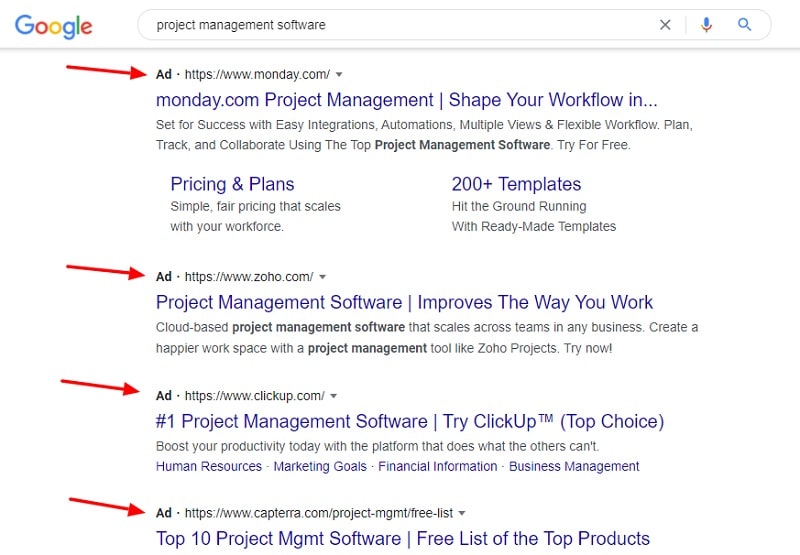
In this example, we entered “project management software” in Google’s search bar. This resulted in four project management software PPC ads displayed in the top four positions. These positions are effective because users tend to click on the first few results they see.
When we scrolled to the bottom of the page, we also noticed there were three PPC ads displayed in positions 14 to 16:
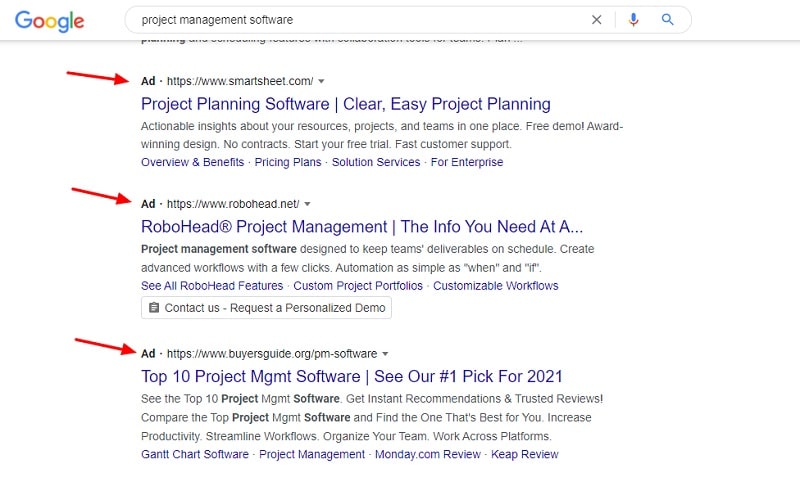
But to be honest, it still surprises us to see that some brands choose to display PPC ads this low in the search results. While choosing to display PPC ads in lower positions is indeed cheaper, it’s typically not the best SEO strategy.
_In other words, if you decide to run PPC ads, paying more for higher placed ads will typically result in more clicks. _
To learn more about PPC ads, check out our article “The Beginner’s Guide to Google Adwords for Small Business.”
Back to Top
Related Content
- 14 Best eCommerce Marketing Tips & Strategies to Boost Sales
- 30 eCommerce Marketing Strategy Examples with Proven Success
- 10 eCommerce Marketing Experts Share Their Top Growth Strategy
- Using Pinterest for Ecommerce: 13 Proven Tips to Generate More Sales
- 11 Common e-Commerce Marketing Mistakes (And How to Avoid Them)
Ready to generate more leads for your eCommerce business?
Generating leads for your eCommerce business is simple with the right strategies in place.
Remember to:
- Set up an email list
- Automate your lead generation process
- Add lead magnets to your landing pages, articles, and website
- Start an affiliate program
- Embed contact forms on your landing pages, articles, and website
- Collect lead data through chatbots
- Offer a free trial
- Make it easy for customers to give you their contact details
- Lead customers to you with an SEO strategy
- Run pay-per-click (PPC) ads

Written by our guest writer Vikas Kalwani
Vikas Kalwani is a product-led growth hacker and B2B Marketing Specialist skilled in SEO, Content Marketing, and Social Media Marketing. He works at uSERP and is a mentor at 500 Startups.



